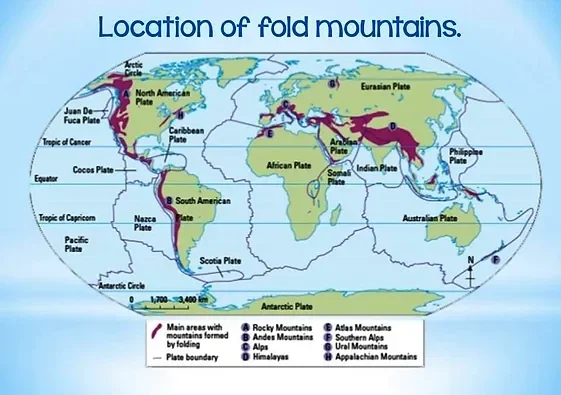-
26 Jun 2025
GS Paper 1
Geography
Day 10: Compare and contrast the formation of young fold mountains and block mountains. Why are fold mountains more prevalent along convergent plate boundaries? (150 words)
Introduction:
Mountains are formed through various geological processes driven by tectonic forces. Among them, young fold mountains and block mountains represent two distinct formations. While fold mountains arise due to compressive forces causing the folding of rock layers, block mountains result from tensional forces leading to faulting and displacement of rock blocks.
Body
Comparison: Fold Mountains vs. Block Mountains
Feature Young Fold Mountains Block Mountains Formation Process Created due to compression when two tectonic plates converge, causing rock layers to buckle and fold Formed due to tensional forces leading to normal faults where blocks of the Earth’s crust are uplifted or downthrown Tectonic Setting Found at convergent plate boundaries (collision zones) Found at divergent plate boundaries or areas of crustal tension Structure Characterized by complex folds, anticlines, synclines, and high elevation Characterized by flat-topped uplifted blocks (horsts) and sunken blocks (grabens) Examples Himalayas, Alps, Andes Black Forest (Germany), Vosges (France), Sierra Nevada (USA) Geological Age Geologically young, still rising due to ongoing tectonic activity Can be older or younger, often more eroded and less elevated Fold mountains are especially common at convergent plate boundaries, where tectonic plates collide. The reasons include:
- Compressive Forces
- When two continental plates collide, immense horizontal pressure pushes rock layers to fold and rise.
- The Himalayas, formed by the collision of the Indian and Eurasian plates.
- Thick Sedimentary Layers
- Long-standing deposition in geosynclines provides soft, foldable rock strata.
- The Alps, folded from sediments of the ancient Tethys Sea.
- Orogeny (Mountain-Building Process)
- Tectonic collisions trigger orogenic movements—folding, faulting, and uplift.
- The Rockies, formed by the Laramide Orogeny.
- Continued Uplift and Seismic Activity
- These regions remain tectonically active, causing ongoing uplift and frequent earthquakes.
- The Andes rise due to the Nazca-South American plate convergence.
Conclusion:
While fold mountains reflect the immense compressive forces of converging plates, block mountains reveal the fractured architecture of the Earth's crustal dynamics. Together, they shape climates, influence ecosystems, and offer valuable lessons in sustainable development and disaster resilience, underscoring nature’s power and humanity’s responsibility.
- Compressive Forces





